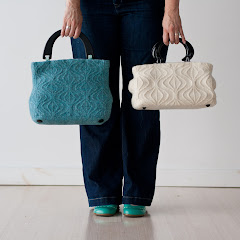
I attended a workshop with Deborah Newton at Vogue Knitting Live in LA a few years ago, which was well worth the price of admission. The fee included a copy of her then-new book Finishing School: A Master Class for Knitters, a welcome addition to my reference shelf, and Newton's own expertise and advice were invaluable! One of the many things I learned that week was that every knitter--young and old, experienced and novice--has their very own set of strongly held opinions about knitting, yarn, and everything associated with them. Deborah Newton, for instance, has near-religious convictions regarding seams in knitted garments--she's a big, big, big fan of 'em. In fact, she was so compelling on the subject of seams that I thought I'd go ahead and try designing a pieced-and-seamed cardigan myself, and Irma is it!
The Irma cardigan is a slightly airier, more feminine (if I can be gender-normative for a minute here) take on the shawl-collar sweaters all the hipster boys have traded their hoodies for as they've hit their mature (ha ha) years. It's worked in an allover columnar lace motif with deep ribbing at the cuffs and hem. And pockets, of course! I worked the original prototype, which is the jade green one shown above, in Simply Socks Yarn Company's solid wool/nylon "house blend." SSYC Solid is a yarn I really adore, not least for its springy plied texture, but also because it comes in, like, EVERY COLOR EVER. I also reknit the pattern, once it was (mostly) written, in Knit Picks Gloss Fingering in a dark gray color called Hawk. That yarn has a hint more luster and slightly crisper stitch definition, and makes the lace motif really pop. It also has an elegant drape in stockinette, thanks to its 30% silk blend, which helps the shawl collar roll while the button band lies splendidly flat, and that's why this yarn is another favorite of mine. (Yes, I have about forty-eleven different "favorite" yarns. Who doesn't?) Were I to make yet another one of these for myself--and I'm not ruling that out--I'd probably try a super-cozy and decadent winter version in Knit Picks Capretta, maybe in the Pesto colorway. But then, I'm a sucker for cashmere.
On the whole, I liked the seamed-garment experience. I learned to sew before I learned to knit, so on a fundamental level, the concept of taking flat pieces and building a garment out of them makes every bit as much sense to me as taking a strand of fiber and building it, stitch by stitch, row by row, into a shape that fits a body (or a hand, or a foot, or what have you). For Irma, I used the crocheted-seam technique Newton demonstrated at the workshop and describes in her book; it was really fun to work, and I think I'll probably continue to use it for shoulder seams in preference to a three-needle bind-off. For one thing, it's easier to unwork and rework if you need to (if you've ever dismantled a thrift-shop sweater to recycle the yarn, you've probably already unworked a crocheted seam!). It also adds a skosh more structure to one part of a garment that really needs reinforcing, while still being flexible and elastic. And because it does use rather more yarn than a mattress-stitch seam or three-needle bind-off, you can even cannibalize it in a pinch if you need a foot or two of yarn to darn or patch a very well-worn garment. Unlike reserved leftover yarn, yarn transplanted from a seam will match the repaired area perfectly, since it's been laundered the same amount as the rest of the garment--so it's kind of a rainy-day account for your sweater! Which is good, because now that other people can actually knit this design for themselves, I'm halfway to wearing the prototpyes out.










